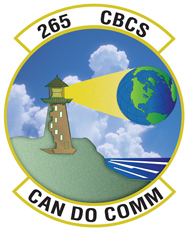
HISTORY OF THE 265TH COMBAT COMMUNICATIONS SQUADRON
The 265th Combat Communications Squadron traces its roots back to 31 October 1950, when the 104th Aircraft Control and Warning Squadron (AC&WS) was established at Fort Preble, South Portland, Maine. The 104th was called to active duty for 24 months on 1 September 1951 and participated in overseas duty at Wheelus AFB, Tripoli, Libya. During this period of active duty, the Adjutant General of Maine was informed that the 104th AC&WS would return to Maine, be decommissioned, and replaced by a Communications Squadron (Operations). The new Squadron received federal recognition as the 265th Communications Squadron (Operations) on 1 July 1953, stationed at the 104th's old home, Fort Preble.
On 1 October 1960, the unit was renamed 265th Radio Relay Squadron (or RADON for short), and moved to the active duty Army facility Fort Williams, in Cape Elizabeth. On 10 June 1964 the squadron moved with its sister squadron, the 243rd Ground Electronics Engineering Installations Squadron, to the new South Portland Air National Guard Station (SPANGS) at 50 Western Avenue, South Portland, Maine, which remains its home today.
The squadron went through various technology and name changes. On 16 March 1968, the unit became the 265th Mobile Communications Squadron (Contingency), 1 April 1976 the 265th Combat Communications Squadron (Contingency), 1 July 1985 the unit changed to the 265th Combat Information Systems Squadron (Contingency) and finally on 1 October 1986 it became the 265th Combat Communications Squadron (CBCS). Another re-organization resulted in the air traffic control element of the squadron becoming its own squadron, the 260th Air Traffic Control Squadron, New Hampshire Air National Guard, in 1998.
Today, the 265th CBCS is currently aligned under Air Force Space Command (AFSPC) and is one of 17 CBCS organized under 2 Combat Communications Groups (CCG), the 226th CCG, and the 254th CCG. The 265th falls under the 226th CCG headquartered at Montgomery, Alabama.
In addition to its federal mission the 265th CBCS has played an important role in the United States, providing protection of life and property in times of natural disaster. In January 1998, the 265th responded to the requests of the Governor to participate in disaster relief efforts in the aftermath of a major ice storm. In October 2005, personnel and equipment were deployed to Louisiana to provide critical communication support in the aftermath of hurricane Katrina. In Sep 2011, the 265th deployed the Joint Incident Site Communications Capability (JISCC) package to Vermont to provide critical communications for the recovery efforts associated with hurricane Irene.
Throughout its history, the unit has deployed people and equipment to other states, including: California, Florida, Georgia, Louisiana, Massachusetts, Michigan, Mississippi, New Hampshire, New York, North Carolina, Ohio, Pennsylvania, South Carolina, Texas, Vermont, Virginia, West Virginia, Washington and Wisconsin; and to other countries: Afghanistan, Bahrain, Colombia, England, Germany, Guatemala, Honduras, Hungary, Italy, Iraq, Kuwait, S. Korea, Oman, Qatar, Panama, Saudi Arabia, Turkey, and United Arab Emirates. Recent deployments by members of the 265th CBCS to support the federal mission include: Kuwait 2003, Iraq 2007-08, United Arab Emirates 2007-2008, Kuwait 2010, Bahrain 2010, Iraq 2010-2011, Afghanistan 2013, and Qatar 2013.
The 265th has received numerous awards and accolades including the Air Force Outstanding Unit award six times in recognition of their superior accomplishments.
Our Mission:
Our State mission is to provide personnel and equipment to protect life and property and to preserve peace, order, and safety of the general public as directed by the Governor of the State of Maine. Our Federal mission in peacetime is to train, equip, and maintain tasked Unit Type Code (UTC) packages in the highest possible state of readiness. In wartime, our mission is to provide UTC packages, complete with personnel and equipment, to support the United States Air Force communications requirements on a world-wide basis.